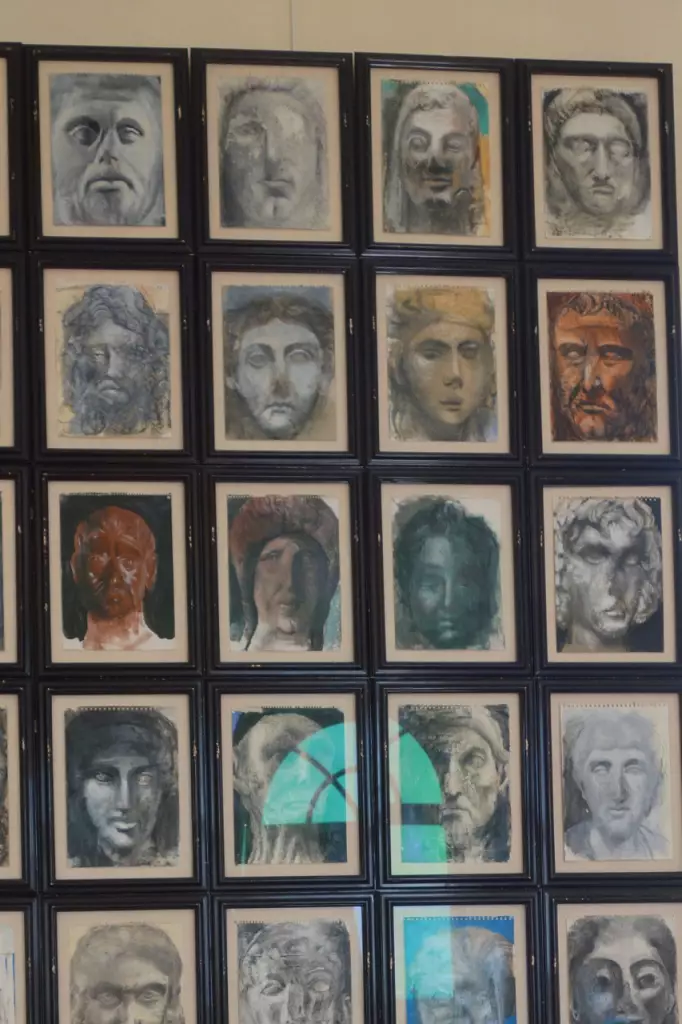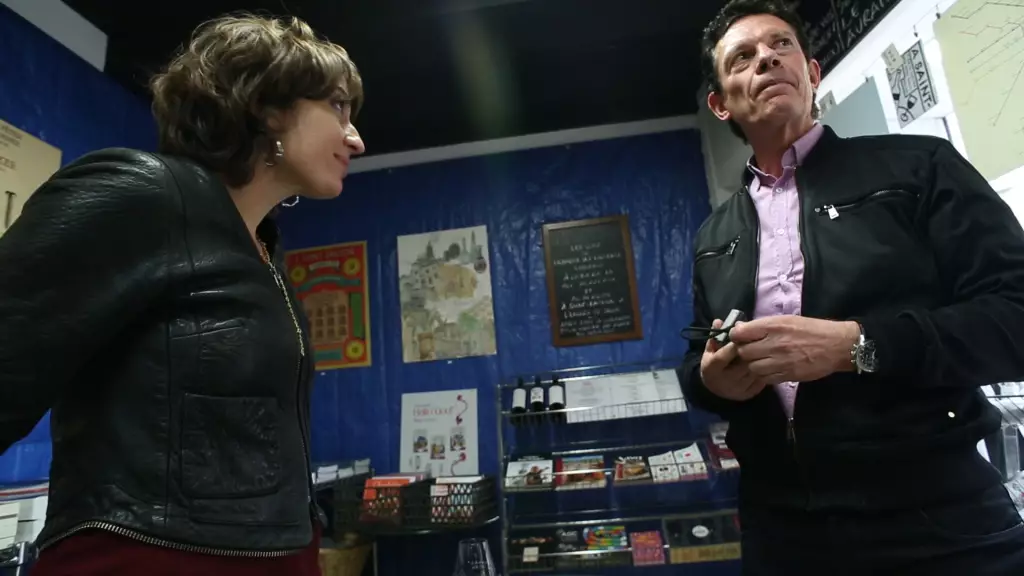I leave my refuge in the middle of the vineyards very early, “intoxicated by the fragile glassful of sunrise”, to use an image by the great poet Jacottet, who was recently published, in his lifetime, in La Pléiade*.
The size of the character and the agony of the hard drive
The day will be intense. It starts at Vieux-Château Certan, where we are welcomed by Guillaume Thienpont. The wine caresses the palate, melting and patrician; it exhales a fragrance of violets. Here, as in many estates, the percentage of new wood has been reduced, to a certain extent; Guillaume says that “the suit needs to fit the character”. He is right. VCC 2013 is apparelled like an aristocrat.
Afterwards, it’s the turn of the Cheval Blanc shindig. Every year, a joyful effervescences dominates here, carefully managed by Pierre Lurton and his team; vibrations and hurly-burly everywhere; it is difficult to remain concentrated. Michel Bettane goes from table to table and shows surprise at the versatility of the samples.
A female taster witters, her lips the colour of petrol; she does not find in this 2013 the aroma of orange peel preserve that, according to her, is part of the essence of Cheval Blanc.
Pierre Olivier Clouet doesn’t know what to answer. I sympathize; in similar cases, my reflex is to run away, into the open air.
The tasting of the Saint-Emilion/Pomerol from the Union des Grands Crus de Bordeaux follows at La Couspaude. The light is beautiful; the tasting includes wines of unequal quality. Some samples are very fragile and unstable. The atmospheric pressure is changing. And why on earth are the tasters confined to one table where it would only take a slight clumsiness to cause the fall of several dozens of glasses and – the great fear of the wine taster – the agony of the hard drive? The room next-door, much larger, is empty.
The silence of the experts
After a lunch as light as a spring breeze, we are on the way to Libourne, “one France’s saddest towns”, in my opinion, in spite of the rivers Isle and Dordogne whose only role seems to be to soften the general melancholy. We have a meeting on Quai du Priourat, at the Moueix establishments. No hosannas and no providence this year, due to the millerandage…Who will save us?
Happily, Trotanoy and La Fleur-Pétrus sparkle with distinction. The film crew that follows me would like to interview Christian Moueix on the vintage. He should attend. In the end, we are told that all the explanations are already available on the vintage’s presentation document. We will have to make do with these few lines. Slim pickings for the film director who then wishes to hear from the amiable Anthony Hanson, consultant at Christie’s; at first, Hanson agrees to speak but then changes his mind.
Towards the dwelling of the gods
We get it: silence is the order of the day. Without further ado, off we go to Petrus, under bright sunshine. In the hall, we find a group of Chinese people hanging on to Olivier Berrouet’s every word. Petrus has a superb taste. Here is one of the great wines of the year!
“Petrus is lucky to have clayey soils; this allowed it to avoid excesses of water and excesses of draught; this may seem paradoxical, as both phenomena happened in 2013. The small harvest due to bad blossoming and the vineyard’s perfect state of health allowed us to wait until the last moment, before the rainfalls of 4 and 5 October. We gathered the heart of Petrus before the rain.”

A contemporary painting hangs in the entrance – a collision of emperors, ancient masters and mythological gods; as if we were on Mount Olympus!
Pictures from a lost world
A few dozen yards from there, in the Lafleur vineyard, we meet a ploughman who works with two solid Percheron horses – “one for heavy ploughing and the other for work that require a lighter touch.” Animal traction has been reappearing in many vineyards in recent years. The ploughman and his horse are ploughing between the vine stocks. This is precision work which allows bringing back the soil that lies between the stocks to the centre of the line, thanks to an element of the mouldboard that is not in the traction axis. The ploughman and his horse are thus able to plough 1.25 acres per day without touching a single stock! We watch them work; the silence is broken only by the noise of the wind and of the harrow, and by the regular behests of the ploughman to his horse; a picture of a world that we thought had gone forever.
A world which appears far removed from the concerns of the Saint-Emilion body politic.
We have a quick drink in the bar next to the Salle des Dominicains, and we chance upon the vineyard manager of a very well-known estate in Pomerol. He is Italian, from Basilicata, and came here two years ago; he fell in love with wine; he will never go back to the South of Italy where he claims people don’t know how to work. I ask him which his favourite Pomerol’s vineyard is; the answer comes in a flash: “Lafleur! Vines are kept in an exemplary fashion!” Well, well…
Gunfight at Saint-Emilion
It is not over; I have an appointment with Isabelle Saporta. She is signing copies of her book ‘Vino Business’ at the bookshop L’Envers du Décor and my colleagues want me to interview her. Her book is currently producing a lot of brouhaha. It even makes waves in the 2012 Classification, which did not expect so much. Hubert de Boüard (Hubertus Magnus in the book), who on Saturday was celebrating the refurbishment of L’Angélus with great formality, actually filed a complaint for libel against Isabelle Saporta and her publisher.
I have half an hour to skim through the 256 pages of Ms Saporta’s book. I immediately state my credentials to Ms Saporta, as opposed to so many false journalists who are in the habit of not reading the book they are supposed to review; I am not a journalist, I have read her book in a hurry, but I know the topic. The scene is set, with a propensity towards grandstanding and sensationalism; the description of Fête de la Fleur is halfway between a thriller (with bodyguards and courtesans) and the pages of a celebrity magazine; but it contains no serious analysis. It doesn’t even come close to ‘La Comédie Humaine’, the masterpiece by Balzac.
The book was reduced to the question of Saint-Emilion and its classification, and it probably deserves better. As they say on Masterchef: “Good work, enjoyable taste, well-seasoned!” Is it enough to make it a great dish? Not at all sure.
I begin the interview (which you’ll be able to see, if it is not edited out, in Sergej Gur’s film) by asking the author if it is true that she wrote “a dirty little book” and that she is “une salope”, a downright bitch, as repeatedly written all over the web in a sexist and surprisingly violent manner; as if the book made many uncomfortable. I was surprised by some reactions, as already underlined by Jacques Dupont. As for the other journalists – though this concerns them: mum’s the word.
Actually, the real question is: is Isabelle Saporta not off topic? Is she not seeing reality through a subjective prism, a prism that could be compared to that of Mondovino – even though we know that no investigation is ever totally objective in this field; rather it puts various viewpoints on reality into perspective.
I ask her if she does not feel that she is somewhat off-topic; she had enough material to write a real novel, in the manner of Balzac, with its characters, its dramas, its turpitudes, its attraction to money disguised as love of beauty. Isabelle Saporta defends her ‘Vino Business’ with great aplomb. Her attitude is both self-promotional and paranoid, which is normal.
On Pharisees and the new restaurant of Hubertus Magnus
The meeting took long enough; it is now 7 pm; there is no crowd outside the bookshop, the atmosphere is quiet and relaxed. Several Saint-Emilion celebrities are present; Claude Bourgignon as well, and François des Ligneris, who offers glasses of wine to bystanders. Jacques Berthomeau has left his quarters for a short time. Dear Hervé Bizeul shows up; I ask him what he thinks of the book. He has no forthright opinion (which is unusual!). He begins to speak in parables, mentions the story of the Pharisees and casing the first stone. I look around: where is the adulterous woman? This story is beyond me.
We are hungry. My Italian fellows and I have dinner nearby, at Hubertus Magnus – pure coincidence. However, this is a nice locale, with an eclectic wine list. It is located on a steep cobbled street. The cuisine is spot-on, though a bit complicated; the terrine of foie gras with eel is a little wonder. I almost forgot to give you the name of the restaurant: Logis de la Cadène.
*Ed.Note: La Pléiade is a prestigious French series of books; entry into it is considered a major sign of recognition for an author in France.
Translation : Alex Limpach








Comment
Billet exceptionnel par la foule de non-dits ! Où l’on voit à quel point Bordeaux est capable d’imposer – dans une certaine mesure – un ton affable et respectueux de cette noblesse historique du vignoble. Ils sont vraiment champions !
Quant à l’opus de cette dame Saporta, qui a au moins l’avantage, dès le début, de bien mettre en évidence « l’agenda » qui sous-tend son argumentaire, il ne fait que de dire en termes parisiens ce que tout le monde bordelais sait depuis des lustres. Comme tout passe si vite maintenant, ce n’est pas cela qui fera bousculer un classement qui risque, effectivement, de passer à la trappe si le juge en charge des plaintes déposées considère le droit avant l’économique.
Le phénomène majeur de cette édition des primeurs est que, pour la première fois depuis 1982, les propriétés se contre-fichent allegro vivace des commentaires de la critique pour fixer leurs prix de sortie. Voilà une révolution, initiée par les premiers et maintenant suivie par d’autres moguls avec aux commandes Pontet-Canet.
Parlons plutôt du résultat des courses : un marché plat, comme les électrocardiogrammes annonçant la fin d’une vie.
La seule planche de salut à une situation intenable sans crise majeure : que 2014 soit un millésime bon et abondant.